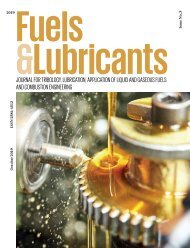Fuels & Lubricants Magazine
Issue No. 2, June 2018
Issue No. 2, June 2018
You also want an ePaper? Increase the reach of your titles
YUMPU automatically turns print PDFs into web optimized ePapers that Google loves.
GREEN CORNER<br />
The advantage of pyrolysis<br />
oil in comparison with direct<br />
using of biomass is easy<br />
handling, transport, storage<br />
and utilization.<br />
cost of the biomass feedstock used to produce it. Incentives<br />
to replace fossil fuels or CO 2<br />
reduction targets<br />
improve the economics further. 4<br />
One of the alternatives for the advanced biofuel<br />
increasing is co-feeding or co-processing of biomass-derived<br />
feedstock as bio pyro oil in a blend with conventional<br />
petroleum feedstock in typical refinery units. 5<br />
This concept has advantages in comparison with conventional<br />
biofuel production. The co-processing uses<br />
existing refining infrastructure: units, catalyst, utilities,<br />
and it needs a low investment of refinery system modifications.<br />
The bio pyrolysis oil can be utilized in FCC process in<br />
conventional refinery configuration. FCC is one of the<br />
most important secondary refinery processes for gasoline<br />
production.<br />
The oleaginous raw material as vegetable oil used<br />
cooking oil and animal fat can also be co-processed in<br />
refinery besides bio pyro oil co-processing.<br />
Legislation and Emissions<br />
The main goal of current European legislation is the<br />
reduction of greenhouse gas emission (GHG) and carbon<br />
footprint. Oil and gas industry tries to produce clean<br />
transportation fuels by adding of different biofuels in<br />
traditional motor fuels.<br />
Biofuels from the first generation as bioethanol and<br />
fatty acid methyl ester (FAME) are limited by current<br />
and future legislation. The highlight is on advanced<br />
biofuels processed from algae, animal manure, lignocellulose<br />
and other waste material.<br />
EU requires from Member States fuel suppliers to<br />
include a minimum share of energy from advanced<br />
biofuels, biogas, renewable fuels of non-bio origin and<br />
renewable electricity from Y2021 according to Draft of<br />
Renewable Energy Directive 2 (RED 2). 6 The minimum<br />
share of renewables is 1.5 % in Y2021 and will increase<br />
up to 6.8 % in Y2030 according to the current proposal.<br />
Within this total share, the contribution of advanced<br />
biofuels and biogas shall be at least 0.5 % in Y2021, increasing<br />
up to 3.6 % by Y2030.<br />
Directive 2015/1513, so-called ILUC Directive<br />
7 recognised this type of wood waste material and<br />
implemented them in Annex 9. All EU Member States<br />
have had obligation to implement Directive until the end<br />
of 2017.<br />
GHG savings of the raw pyrolysis oil according to the<br />
literature are really high and above of other biofuels and<br />
it is about 85-95% for heat and power applications. In<br />
comparison with favourable fossil fuel, the combustion<br />
emission is significantly reduced. The abatement of over<br />
99 % of SO X<br />
emission, over 36 % of NO X<br />
emission and<br />
over 72 % of CO emission are noticed. 8<br />
Properties of Bio Pyrolysis Oil<br />
The bio pyrolysis oil is completely different material<br />
from fossil oils which complicate their usage in the<br />
petroleum industry as motor fuels. Unique physical and<br />
chemical properties of bio pyro oil make it very challenging<br />
from the analytical point of view.<br />
Bio pyrolysis oil was used primarily in boilers and furnaces<br />
as fuel oil replacement for electricity and heat production.<br />
The properties of bio pyro oil for this purpose is<br />
described by ASTM D 7544 method. 9<br />
It is described by International Energy Agency (IEA)<br />
as: “Product of thermal treatment of lignocellulosic biomass,<br />
typically at between 450-600 °C at near atmospheric<br />
pressure or below, in the absence of oxygen using<br />
small dry biomass particles. The solid by-product is char.<br />
Bio pyro oil is complex mixture oxygenated hydrocarbon<br />
fragments derived from biopolymer structures. It typically<br />
contains 15-30 wt. % of water. Common organic components<br />
include acetic acid, methanol, aldehydes and ketones,<br />
cyclopentenones, furans, alkyl-phenols, alkyl-methoxy-phenols,<br />
anydro sugars and oligomeric sugar water insoluble<br />
lignin-derivate compounds. Nitrogen- and sulphur containing<br />
compounds are also sometimes found depending on<br />
biomass source”. 10<br />
The bio pyro oil composition is very complex and varies<br />
in accordance with biomass feedstock, process and<br />
operating conditions. Typical properties of bio pyro oil<br />
are present in Table 1. 10<br />
The bio pyro oil is highly polar material, miscible with<br />
polar fuels. It contents between 15 to 30 wt. % of water<br />
in a microemulsion. Water is undesirable components in<br />
motor fuels due to corrosion effect, emulsion formation<br />
and problems in burners. Oxygen content is very high<br />
accordingly. The acidity of bio pyro oil is also high, so<br />
corrosion effect can be expected as well. Viscosity is very<br />
high and it is connected to combustion and engine application.<br />
Viscosity is increased by ageing and depends<br />
on temperature. Pour point is satisfied to compare to<br />
<strong>Fuels</strong>&<strong>Lubricants</strong> No. 2 JUNE 2018 31







